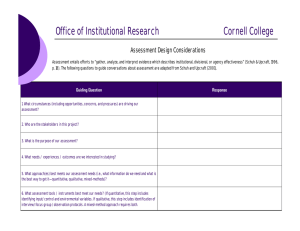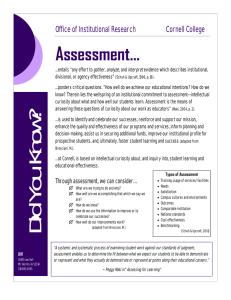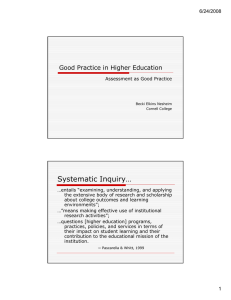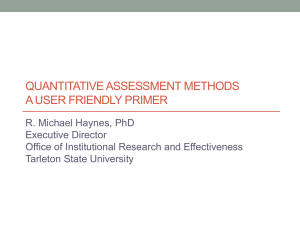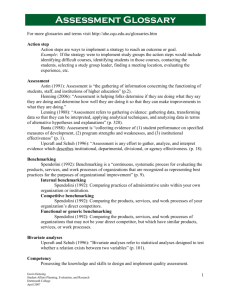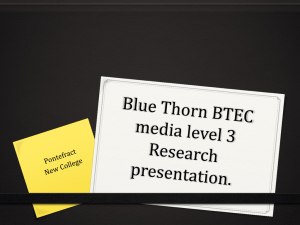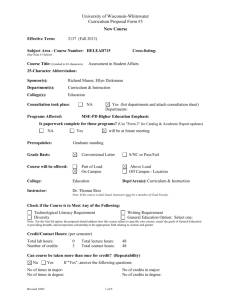Assessment 101: A Guide for Higher Education Goals of the program:
advertisement
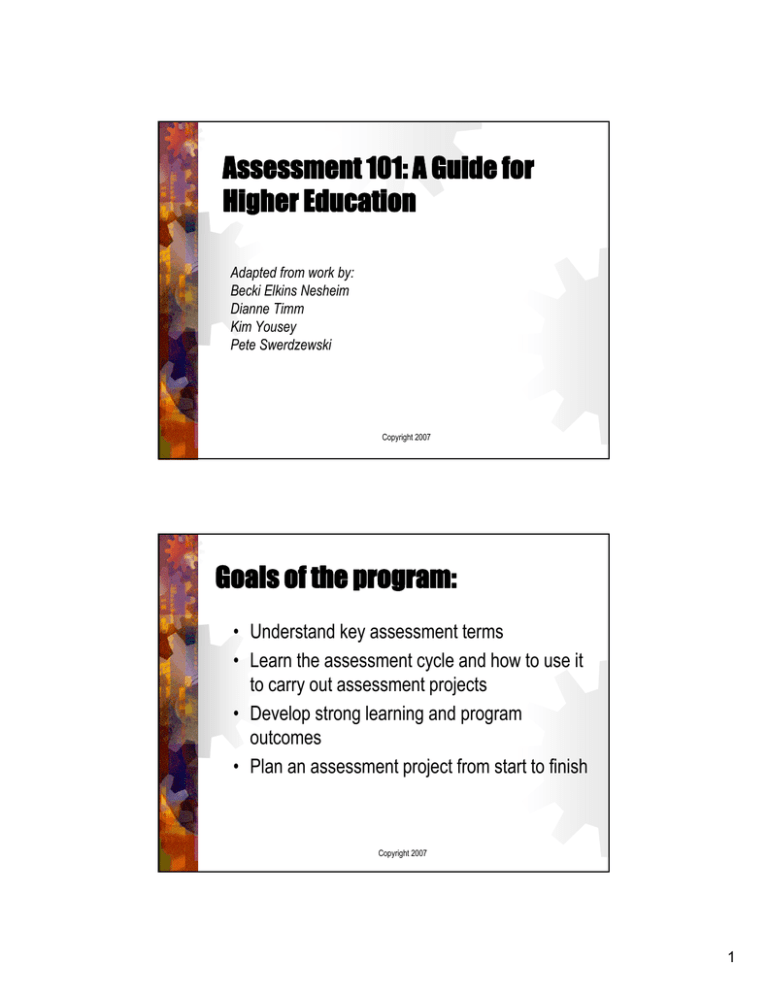
Assessment 101: A Guide for Higher Education Adapted from work by: Becki Elkins Nesheim Dianne Timm Kim Yousey Pete Swerdzewski Copyright 2007 Goals of the program: • Understand key assessment terms • Learn the assessment cycle and how to use it to carry out assessment projects • Develop strong learning and program outcomes • Plan Pl an assessmentt project j t ffrom start t t tto fifinish i h Copyright 2007 1 Assessment • “Any effort to gather, analyze, and interpret evidence id which hi h ddescribes ib iinstitutional, tit ti l di divisional, i i l or agency effectiveness.” (Upcraft & Schuh, 1996, p. 18) • A systematic process which includes research, data gathering, data analysis, and evaluation in an effort ff t to t guide id goodd practice ti andd iimprove student learning and development. (Erwin, 2002; Palomba & Banta, 1999) Copyright 2007 Evaluation • The process of analyzing results in a manner that makes the results usable. (Upcraft, 2003; Upcraft & Schuh, 1996) • It is part of the assessment process. (Upcraft & Schuh, 1996). Copyright 2007 2 Evaluation • FORMATIVE EVALUATION • P Provide id ffeedback db k • Modify and/or shape a program or service • Improve a program or service • SUMMATIVE EVALUATION • Judge a current program or service for quality lit and/or d/ worth th • Based on previously established standards (Palomba & Banta, 1999) Copyright 2007 Research • The method of gathering information to support and/or guide the assessment process. • Qualitative • Quantitative • Mixed Methods Copyright 2007 3 Assessment Cycles • How you organize your assessments • Assessment systems vs. ad hoc systems • Adaptable to different institutions and goals Copyright 2007 Example #1: Comprehensive Assessment Model • • • • • • • Usage Numbers S Student needs Student satisfaction Environments Learning Outcomes Comparable p ((Benchmarking) g) Using National Standards (i.e. CAS) (Upcraft & Schuh, p. 27) Copyright 2007 4 Example #2: Guiding Questions • • • • • • • • • • • • What’s the problem? What’s the purpose? Wh will Who ill be b studied? t di d? What’s the best assessment method? How do we decide who to study? How should the data be collected? What instrument(s) should we use? Who should collect the data? How should we record the data? How do we analyze the data? How do we report the results? How do we use the results? (Upcraft & Schuh, p. 316) Copyright 2007 Example #3: Assessment Cycle • • • • Identify Outcomes Gather Evidence Interpret Evidence Implement Change (all centered around Mission/Purpose, Mission/Purpose Educational Objectives) (Peggy Maki) Copyright 2007 5 Example #4: Practical Inquiry • • • • • • What topic are you interested in? Wh t would What ld you lik like to t know k about b t your topic? t i ? (Question) (Q ti ) How can you answer your questions? (Method, data collection) What did your data tell you? (analysis) How does that inform practice? (implications/report) What is the next question? (feedback loop) (Yousey) Copyright 2007 A Comprehensive Model: Learning or Operational Outcome Report and U Use Results Data collection methods/plan project Mission Goals Learning Objectives Collecting D Data Analyze Data Copyright 2007 6 Putting the Cycle Into Action: Creatingg an Assessment Plan begins g byy going step-by-step through the cycle Copyright 2007 Step #1: Learning Outcomes • Objectives which help define in clear and simple terms how student affairs programs and services contribute to student learning and fit institution mission. (Bloland, Stamatokos, & Rogers, 1996) • Objectives or goals that can be measured to show student learning through student affairs programs and services. (Bresciani, Zelna, & Anderson, 2004) Copyright 2007 7 Learning Outcomes • Cognitive Learning Outcome • General skills, intelligence, higher order cognitive development • Affective Learning Outcome • Attitudes, values, and self-concept (Alexander & Stark, Stark 2003) Copyright 2007 Developing Outcomes Outcome: An outcome is the desired effect ff t off a service i or iintervention, t ti bbutt is much more specific than a goal. It is participant or output centered. Example: As a result of participating in the Pathways to Success Program students will increase their first year grade point average. (Compared with the objective: enhance student academic achievement.) Copyright 2007 8 Good Outcome Statements • • • • Student learning outcomes translate intentions into actions Describe what students should demonstrate or produce Use action verbs Align with other intentions (institutional, (institutional departmental) Copyright 2007 Good Outcome Statements • • • • Map to practices Are collaboratively authored Reflect/complement existing national criteria Are measureable Maki, P. L. (2004). Assessing for learning: Building a sustainable commitment across the institution. Copyright 2007 9 Individual Exercise • Pick one program/service where you know that learning is occurring • Make a list in your own words of what students are learning • Write a “quick and easy” learning outcome: By the end of this program students will…. will (think, feel, do differently) Copyright 2007 Group Exercise • Gather by area of interest • Share your outcomes/give feedback Copyright 2007 10 Step #2: Planning Methods Begins with: How best to measure your outcome? (Qualitative, Quantitative and Mixed Methods) Ends with: Creating a plan of the who/what/where/when/how h / h t/ h / h /h off your assessmentt Copyright 2007 Qualitative • Researcher(s) gathers information from the world around them. (Bogdan & Biklen, 2003) • Researcher(s) make multiple constructions and interpretations of the world they are studying. (Merriam & Associates, 2002) Copyright 2007 11 Quantitative • Research designed to gather information and test a particular hypothesis or theory. • Uses simple to complex statistics. (Erwin, 1991) Copyright 2007 Things to consider: • How best to answer your question? (Qualitative, Quantitative and Mixed Methods) • What’s in your tool belt? • Timeline • Resources ($$, time, human) • Sampling • KISS Copyright 2007 12 Measuring Outcomes When measuring learning outcomes make sure that the measure… measure •Matches: Measure directly matches to the outcome it is trying to measure •Appropriate pp p methods: Uses appropriate pp p direct and indirect methods •Targets: Indicates desired level of performance Copyright 2007 Measuring Outcomes • Useful: Measures help identify what to improve • Reliable: Based on tested, known methods • Effective and Efficient: Characterize the outcome concisely Adapted from Paula Krist, Director of Operational Effectiveness and Assessment Support, University of Central Florida, May 2006. Copyright 2007 13 Group Exercise • Look at your outcomes and discuss some ways (or methods) you can answer the question • Bounce off different ideas, why would one method be better than others? Copyright 2007 Step #3: Collecting Methods Easy if you plan ahead • Who – is being asked, who is conducting • What – method • Where – logistical space or web space • When – timing is everything • How – are you carrying it out, analysis? Copyright 2007 14 Individual Exercise (if time) • After discussing a method, how would you plan the: th • • • • • Who? (who is doing work, who is participating) What? (method, what do you need to design?) Where? When? How? • Remember KISS!! Copyright 2007 Step #4: Report and Use • Know your audience • Short is better • Focus on results AND implications (So now and So what) • Use non-technical language content, grammar grammar, etc etc. before • Check for content distributing • Follow-up with those implementing results Copyright 2007 15 References • • • • • • CLUs assessment system. California Lutheran University, Office Assessment and Educational Effectiveness. Retrieved on-line May 21, 2007, from http://www callutheran edu/assessment/cycle/ http://www.callutheran.edu/assessment/cycle/ Erwin, T.D. (1991). Assessing student learning and development : A guide to the principles, goals, and methods of determining college outcomes. San Francisco: Jossey-Bass. The course assessment cycle. George Washington University, Office of Academic Planning and Assessment. Retrieved on-line May 21, 2007, from http://www2.gwu.edu/~oapa/course_assessment/ Maki, P.L. (2004). Assessing for learning: Building a sustainable commitment g VA: Stylus. y across the institution. Sterling, Upcraft, M.L., Schuh, J.H. (1996). Assessment in student affairs: A guide for practitioners. San Francisco: Jossy-Bass Yousey, K.M. (2006). The best of both worlds: Coupling research and assessment. About Campus, Sept-Oct, 23-25. Copyright 2007 16
